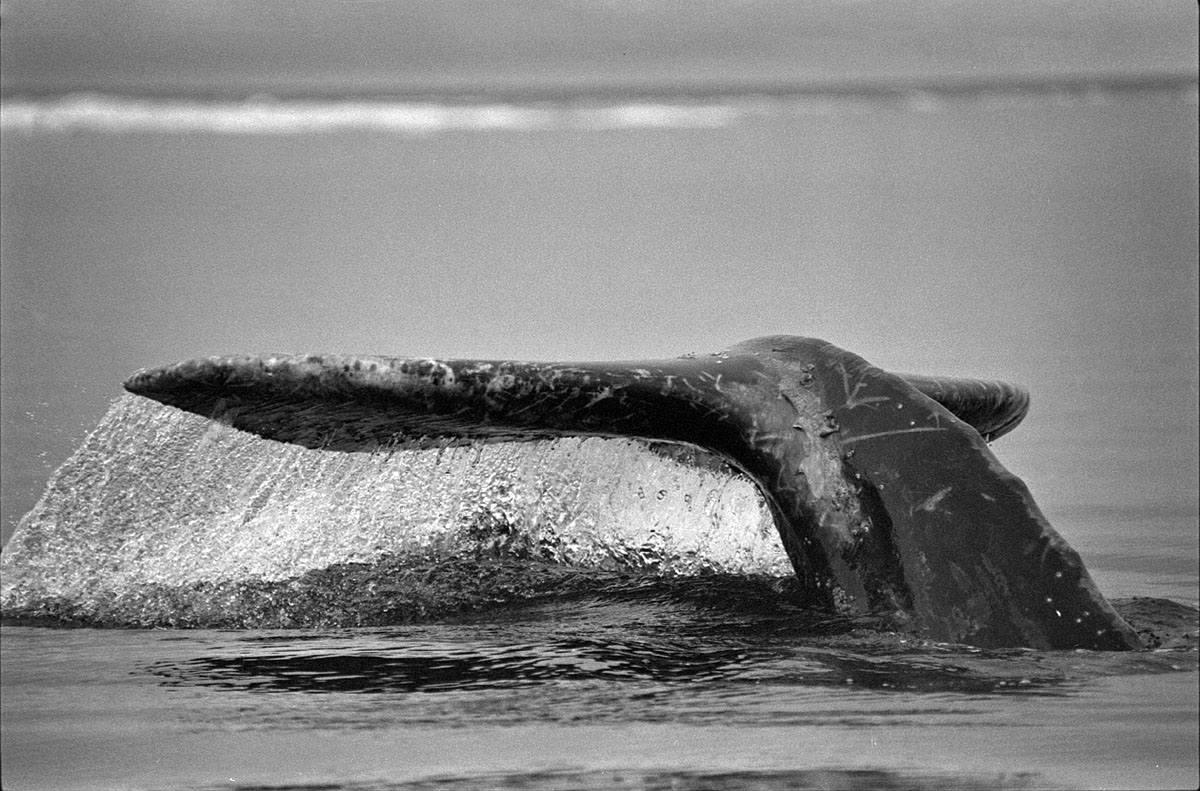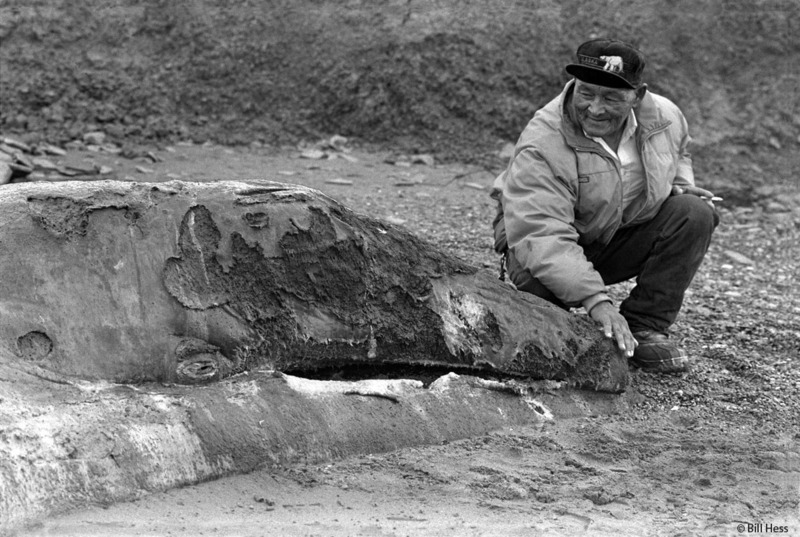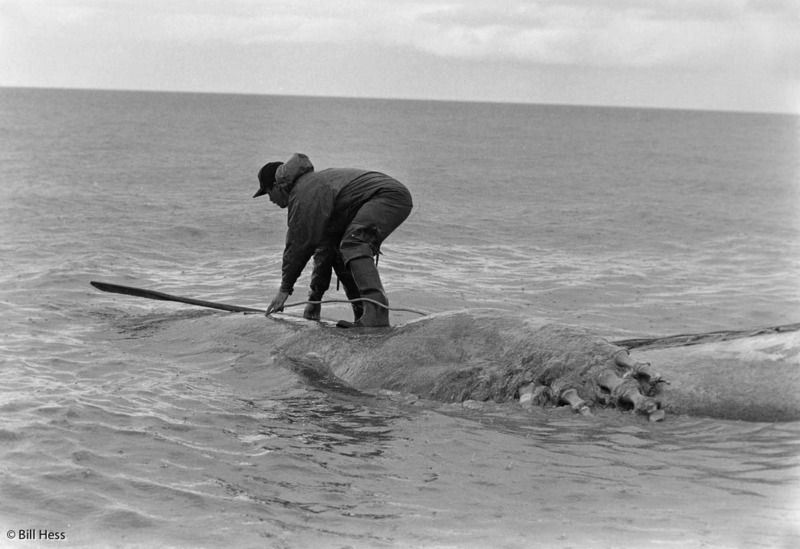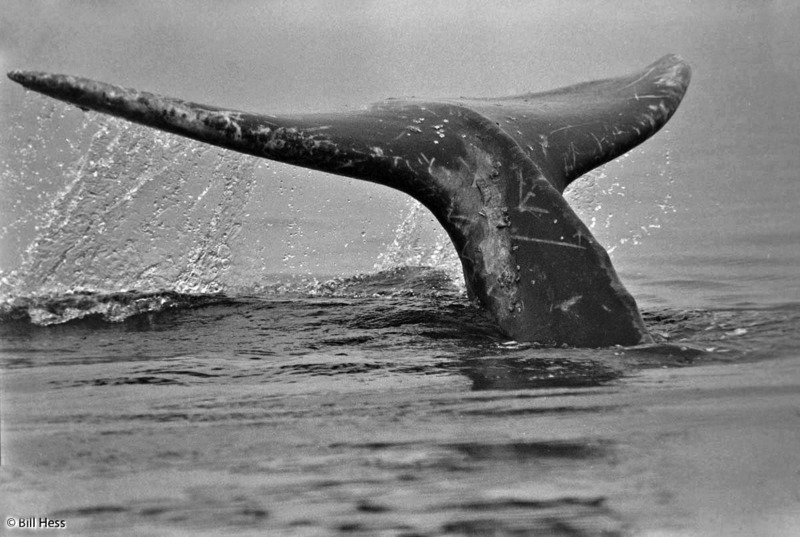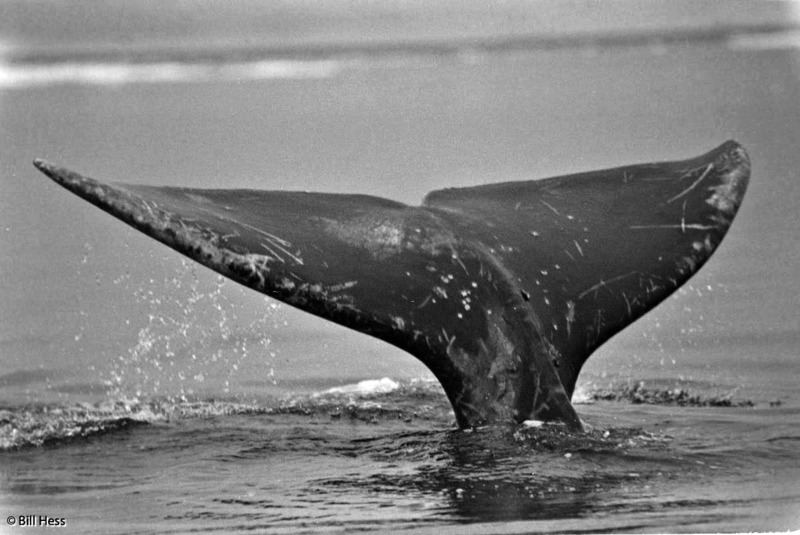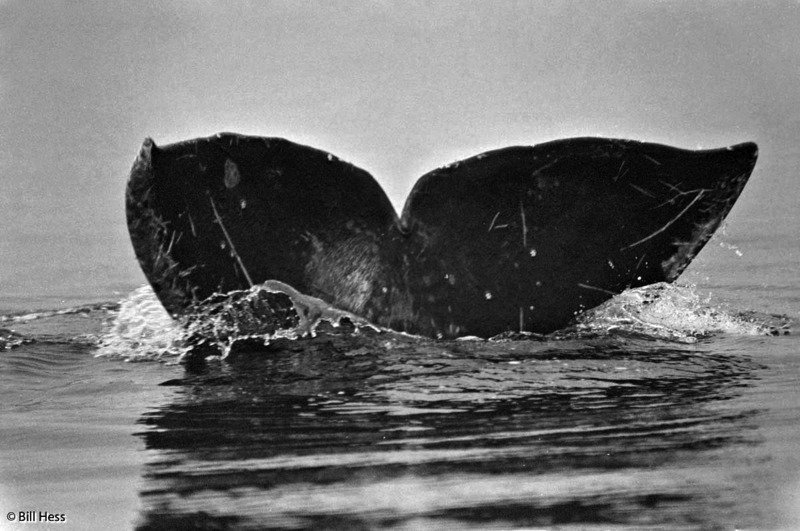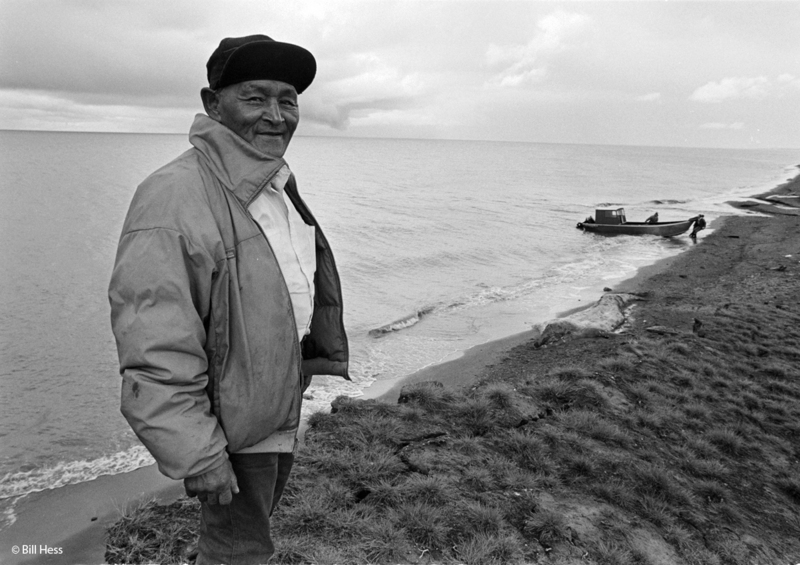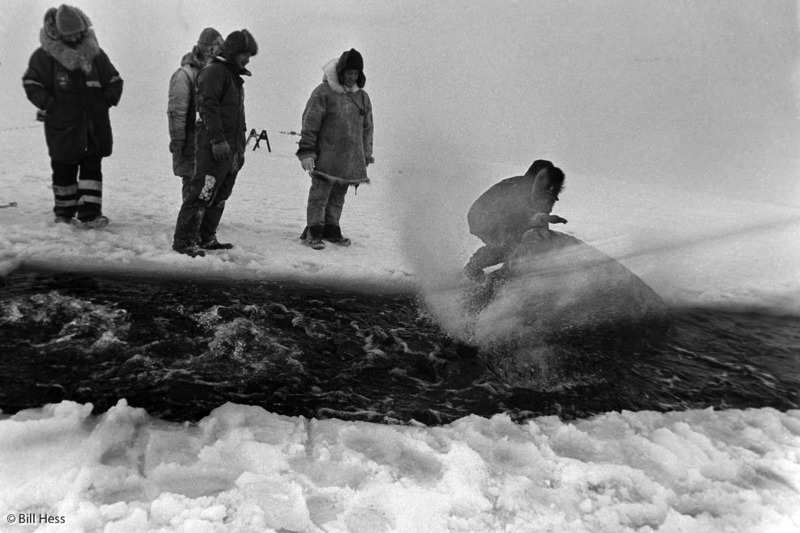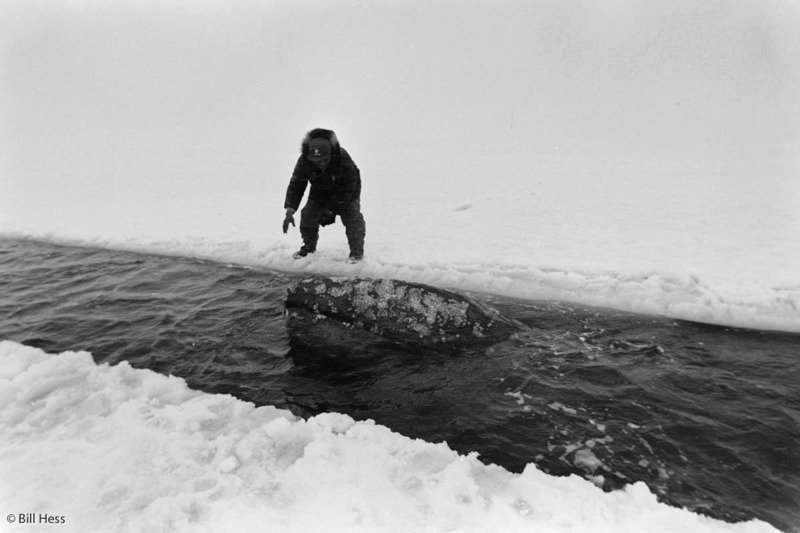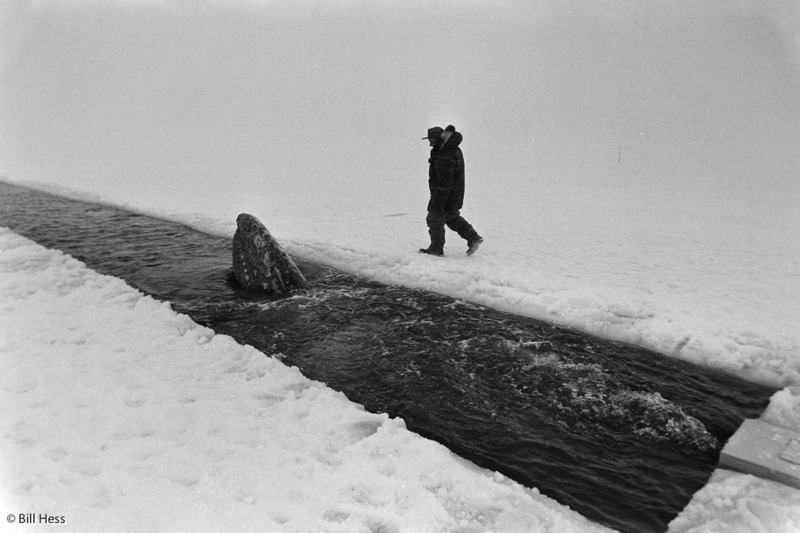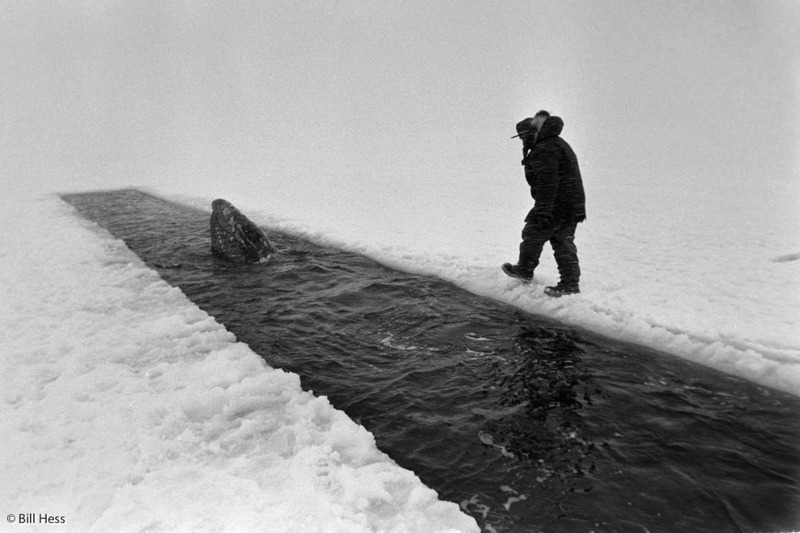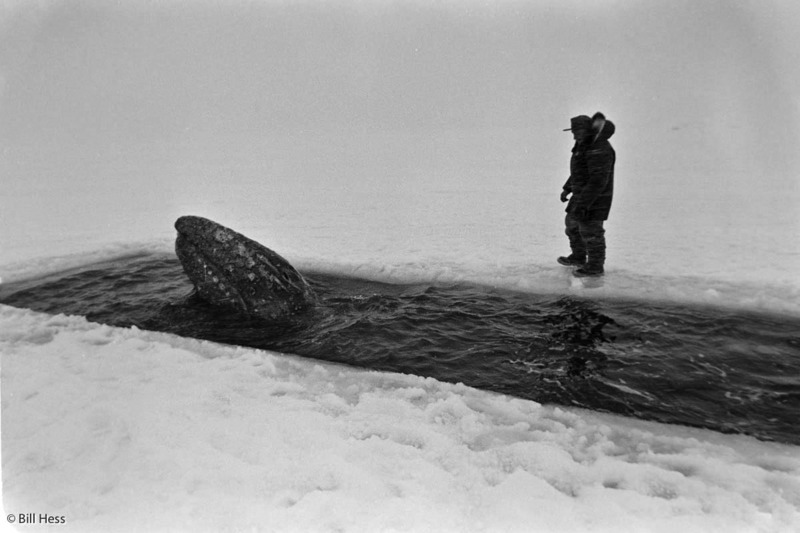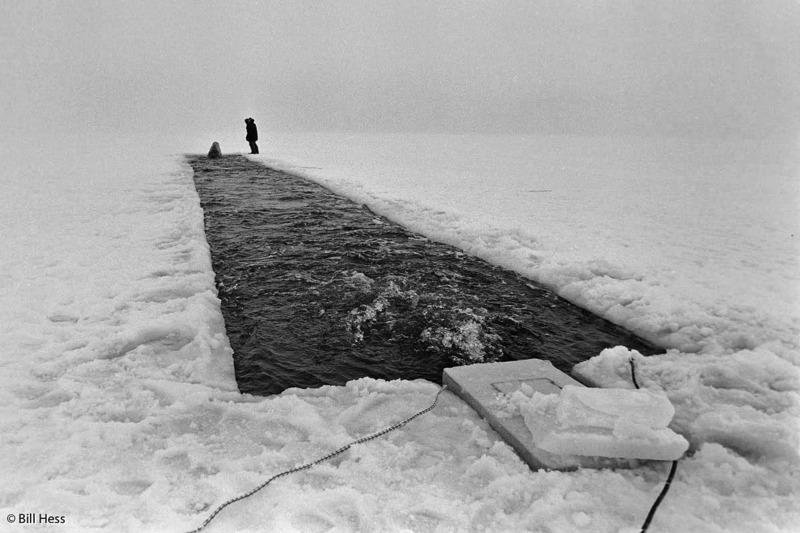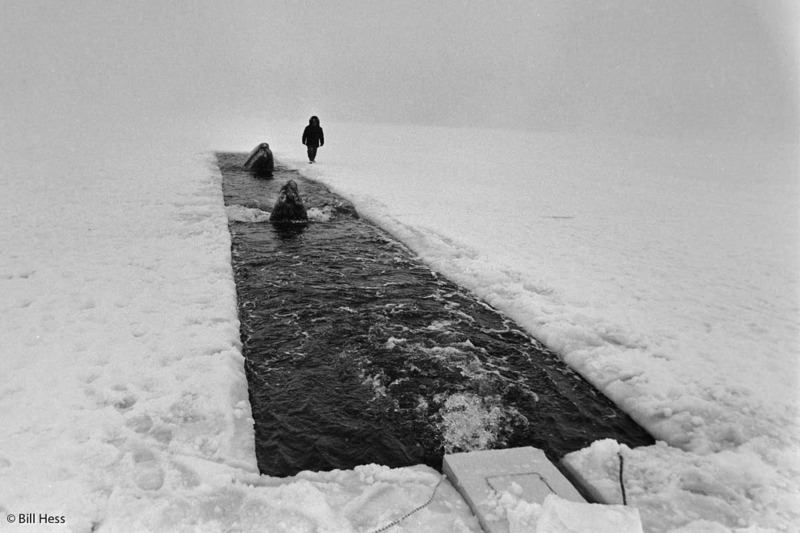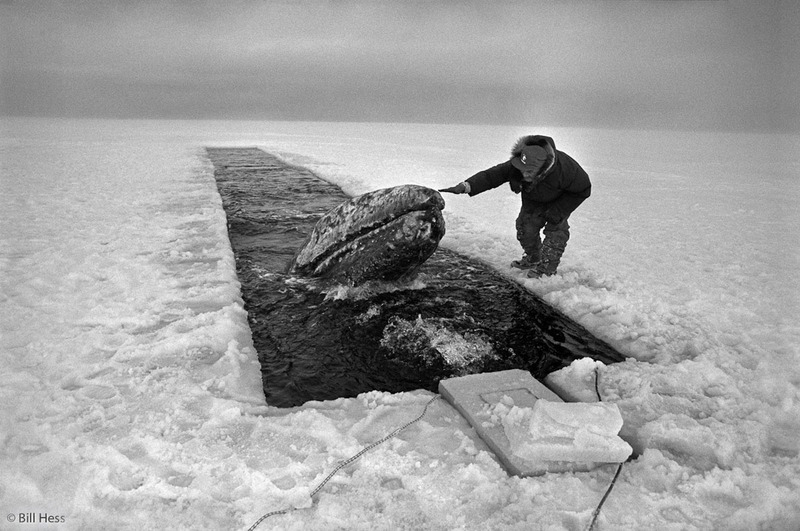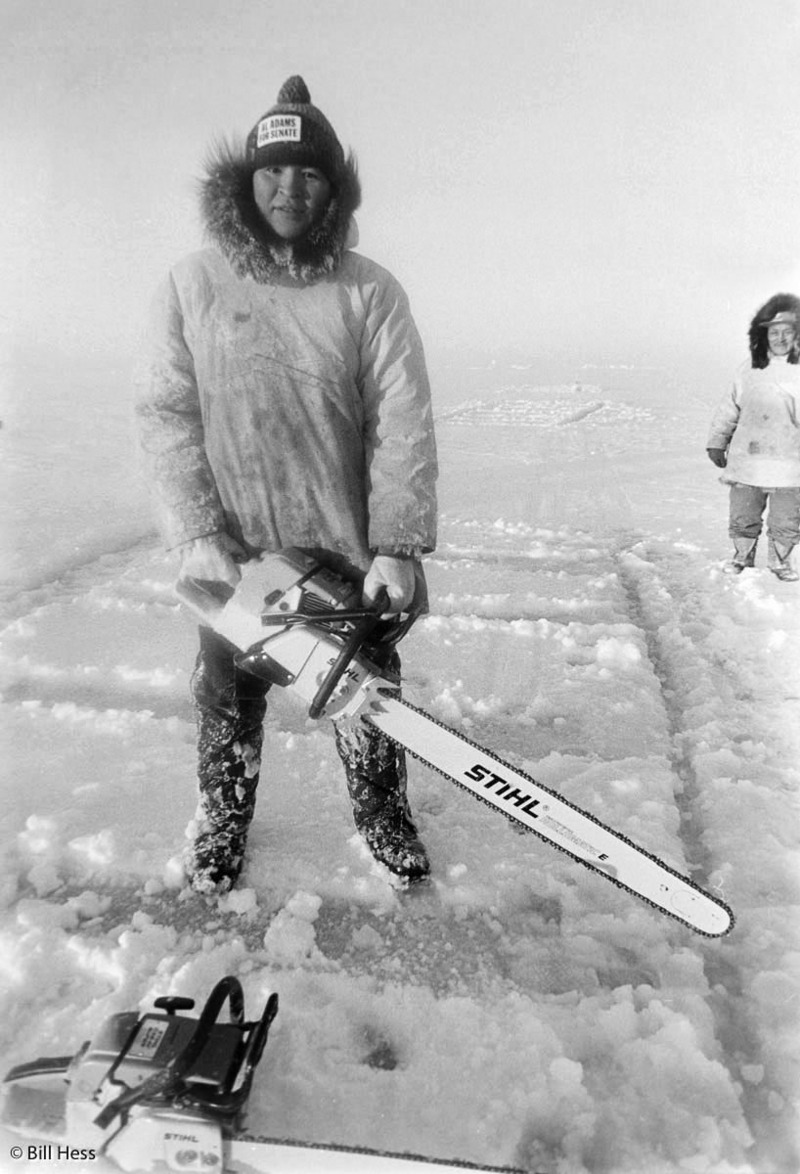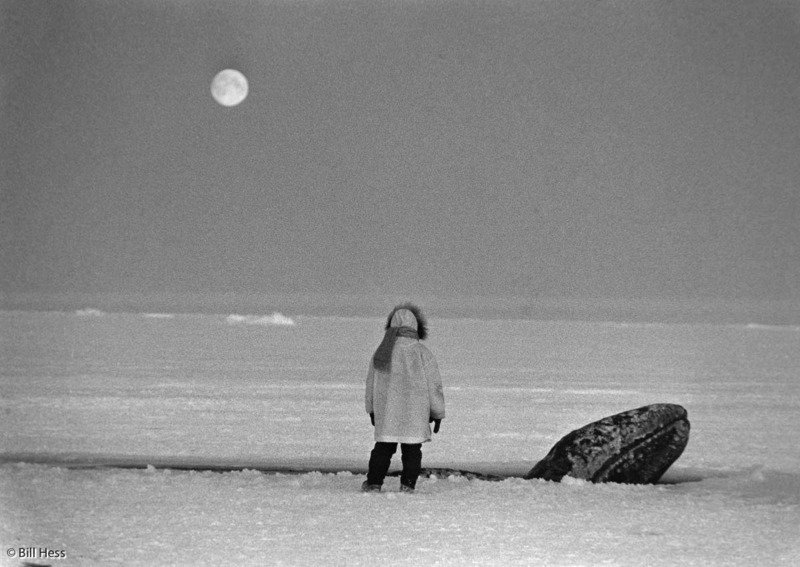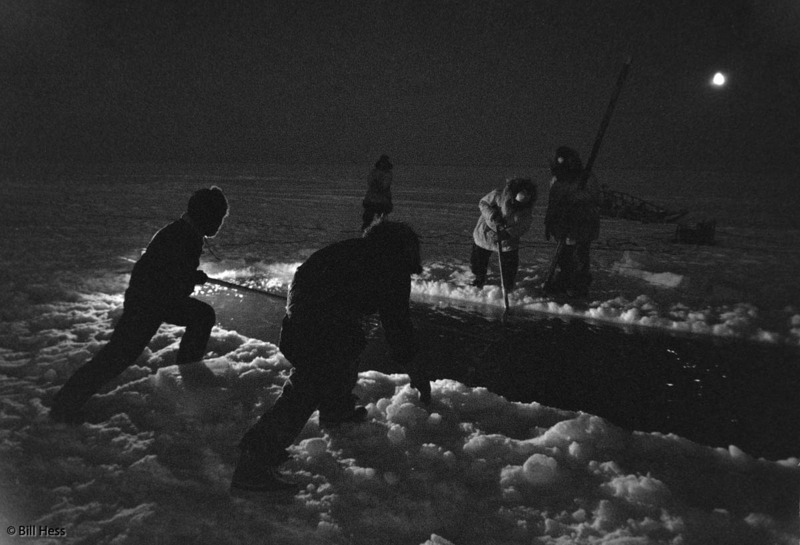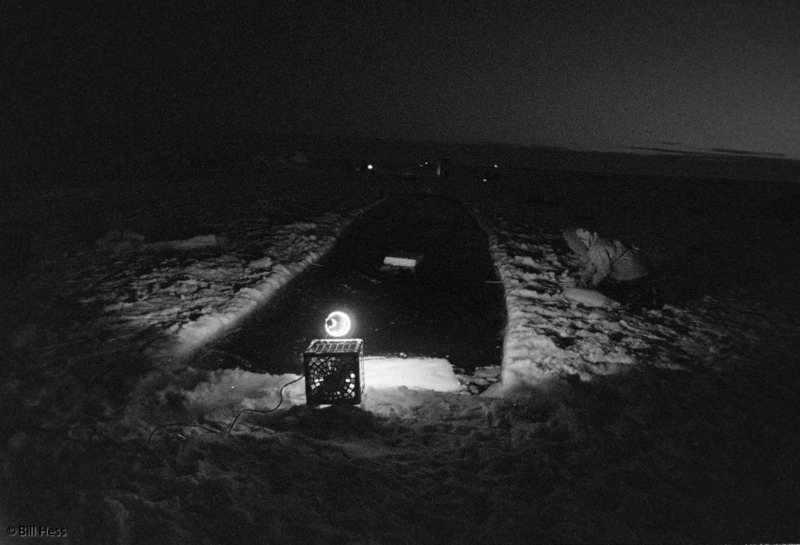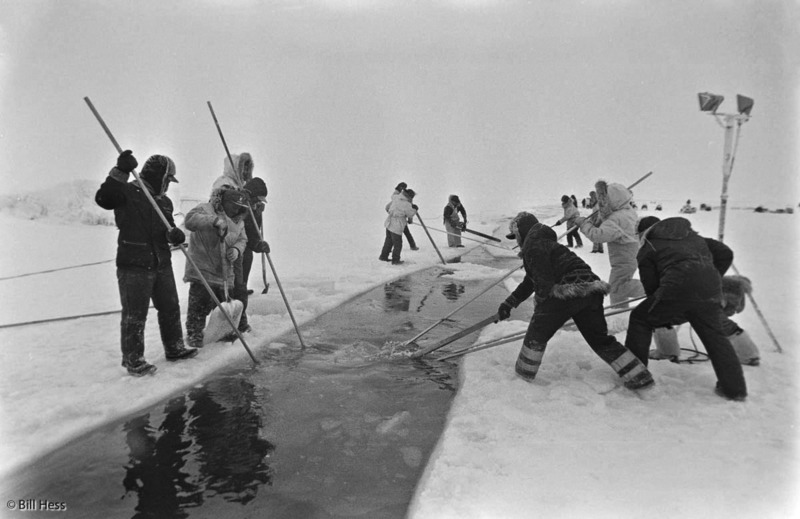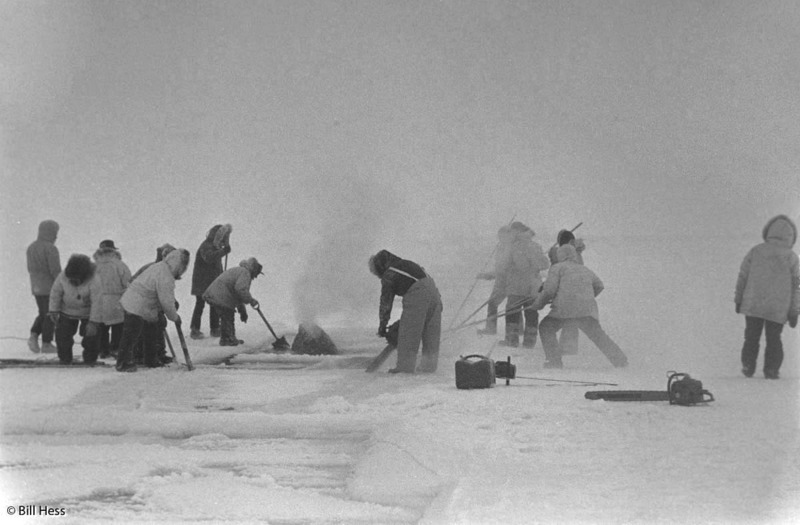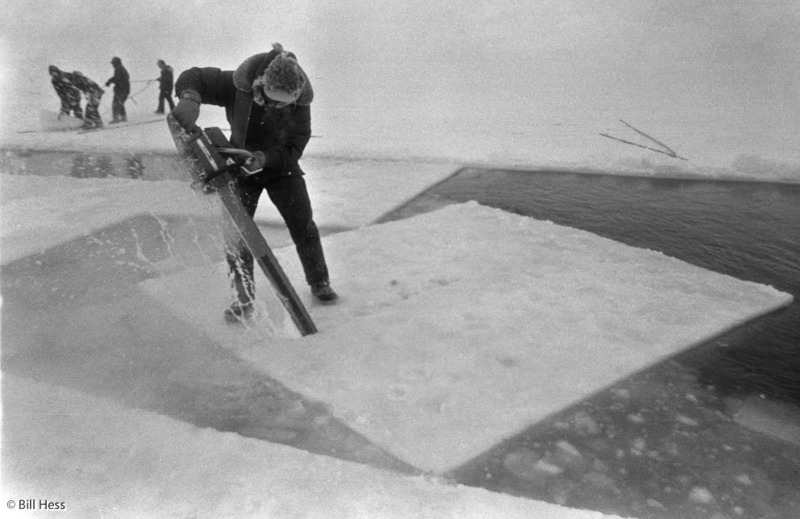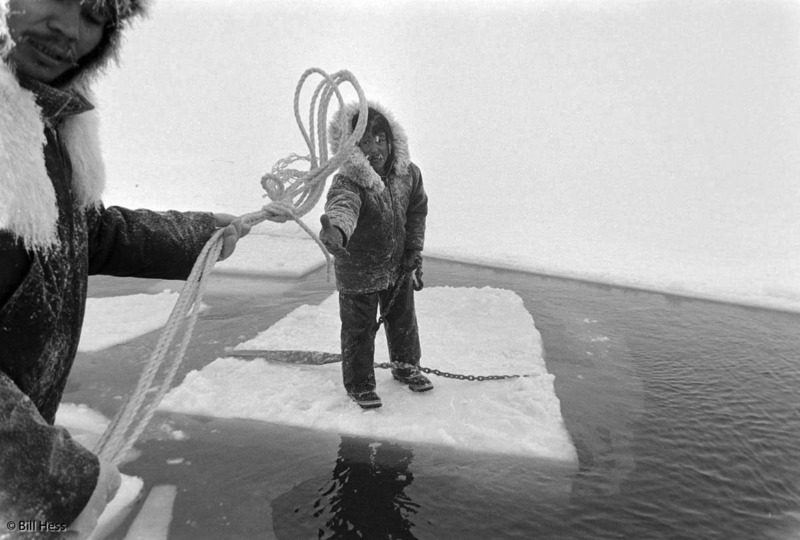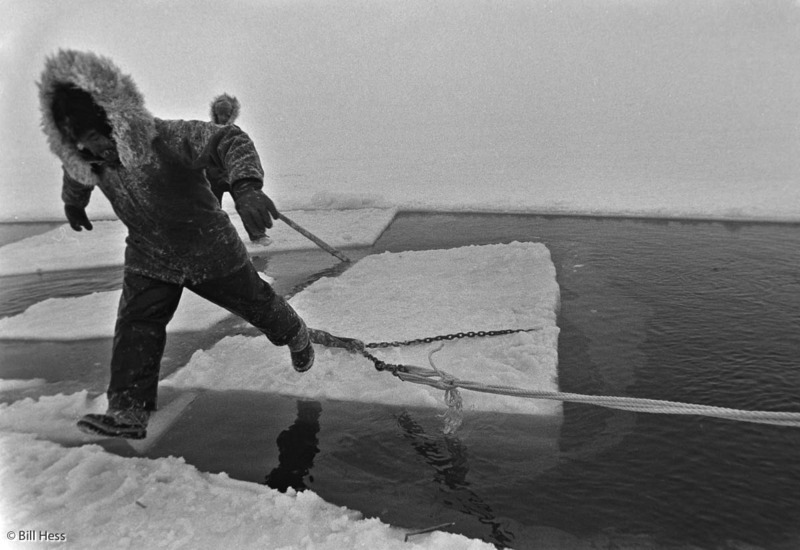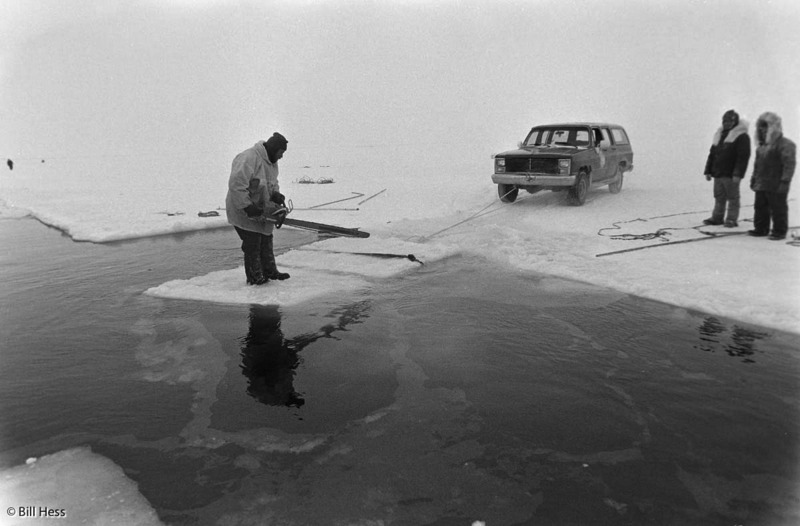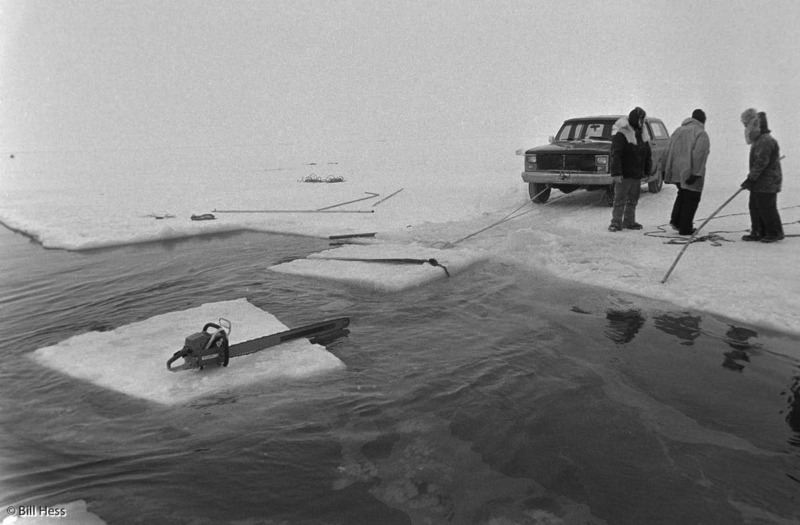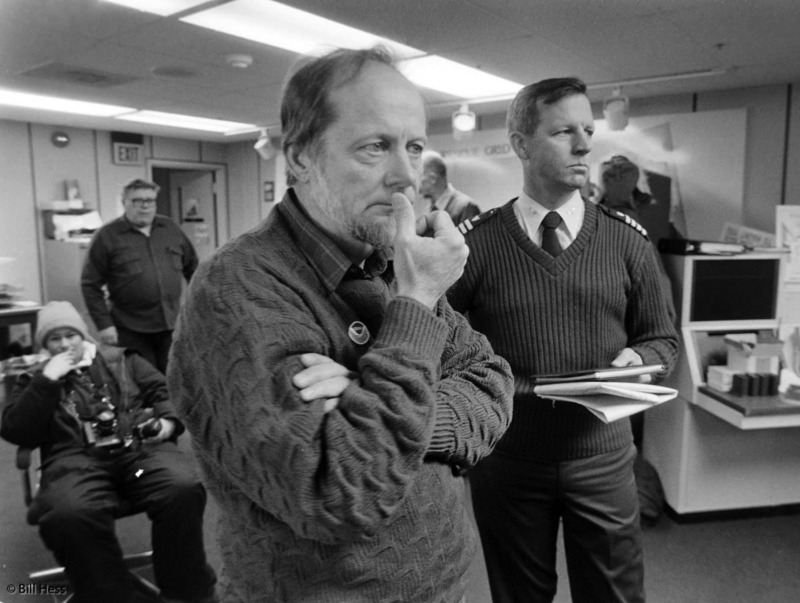
As the two Soviet icebreakers drew near, Ron Morris announced that he and two military officials, NOAA Rear Admiral Sig Petersen and Coast Guard Captain Jim McClelland, standing here to the right of Morris, would be flown out to greet them in the large North Slope Borough helicopter, known as Big Bird. No media would be allowed. Naturally, the media protested and when the captains of the Soviet ships found out, they reportedly protested as well, as did high Soviet officials. They wanted the world to know of the good work they were doing. So Morris backed off, and agreed to take a media contingent.
I wanted to be part of that contingent, but Morris had other ideas. He was going to take a media pool, which would include just one photographer, - Jack Smith of the Associated Press. Morris was adamant - I had to stay on shore. I pressed my case - I was the only photographer who had documented this from the beginning, that I was making a comprehensive photo essay record the likes of which no other photographer could, and that I was local. The media pool would be of no benefit to my work at all. If I got cut out now, I would just get cut out. Smith's photos might well serve the newspapers of the world, but not my more comprehensive essay.
Morris agreed that I had a point and said he would think about it. Soon, the interpreter who would traveling with them showed up on the stairs with a list of names of all the media going. This list would be presented to Soviet officials on the ship who would authorize those individuals to come on board. My name was not on the list. I went to Morris, and asked him about the omission. "Bill, I told you I was taking the pool, and no one else!" Morris retorted sharply, as if our earlier discussion had never taken place. "I told you that! No. You can't go. I'm sorry, but I'm responsible here, I'm in charge, and I have made my decision."
I could see no good reason for this at all. There would be plenty of room on the Big Bird. NSB Search and Rescue director and pilot Randy Crosby then put in a plea to Morris on my behalf, but Morris was just as admamant with him. Crosby couldn't really argue with him, because Morris was acting on behalf of President Ronald Reagan, whose wife, Nancy, had told the entire world that she was praying for the whales.
Still, I wasn't ready to give up. I presented my case to Rear Admiral Petersen, but he did not even acknowledge my presence. He did not look at me, he did not glance at me, he did not say, "yes," he did not say, "no." He ignored me as thorougly as one human being can ignore another, as though I were empty space, occupying nothing. He ignored me so thoroughly that, for a moment, I began to wonder if I were really there at all.
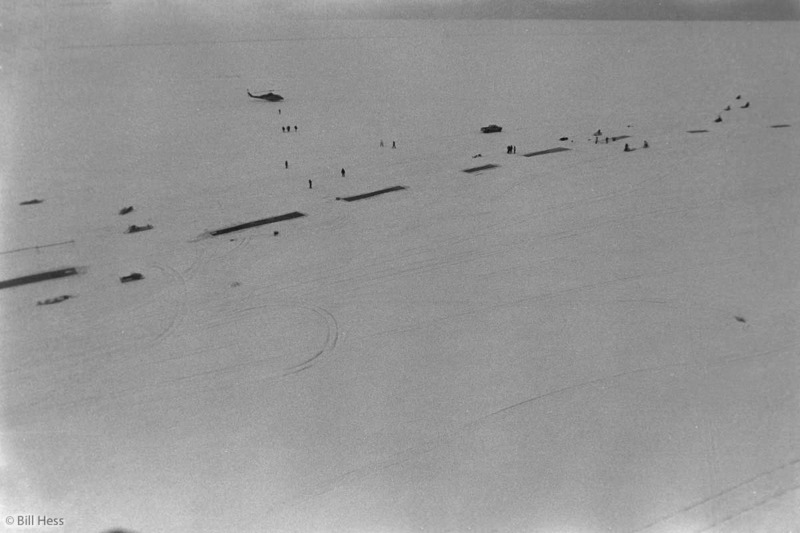
When I set my mind to something, I don't give up easily, but now I felt helpless. Randy took off with the entourage in the Big Bird. What to do now? I could go back to the whale site and photograph the cutting of more holes. The photos would look pretty much as my other photos - the photos that mattered today would be of the Soviet icebreakers. The only way I could get there would be by helicopter, from Search and Rescue. I could try to sneak out to the pressure ridges by snowmachine, but anyone there within good photographic range of the icebreakers as they drew near ran a high risk of getting killed, once the breakers struck the ridge and the shattering spread out in all directions.
Remember this when you watch the conclusion of the movie, Big Miracle.
So, even though it appeared hopeless, I decided to hang out at the hangar and just see what might happen.
Time passed, with me in the hangar, accomplishing nothing... an hour, two hours... I can't remember for certain. Maybe three, possibly even four, but I don't think so. It felt interminable, though. At about 2:00 in the afternoon, NSBSAR pilot Steve Cox told me that Randy was bringing some Russians from the ship in Big Bird to see the whales. He was going to fly down to greet them in the Long Ranger. Did I want to come along and photograph the Russians looking at the whales?
I hopped into the Long Ranger with Cox and off we went. As we drew near to the holes, I saw a potential picture that a number of my colleagues had been getting, but that I had so far completely missed - the holes from the air. They now extended close to four miles offshore. I had been traveling back and forth by snowmachine. My more southerly and less northerly adapted colleagues would catch rides on the media flights launched each day by NSBSAR and so had been able to photograph what I had not.
Now, I saw the holes, and shot this and one more frame. It was not the angle I wanted and I was shooting through plexiglass. Cox assured me that when we returned to the hangar, he would fly me to whatever angle I wanted and open the door for me.
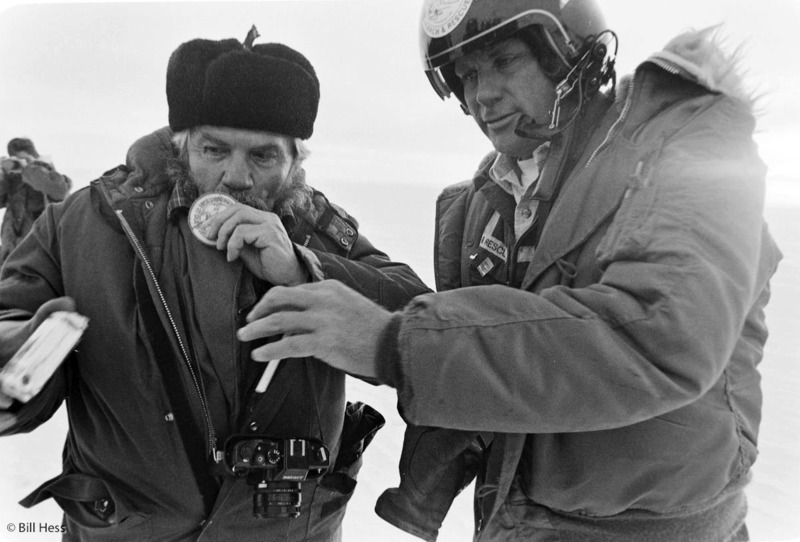
As soon as I stepped out of the helicopter, I was met by Dan, also of NSBSAR who was flying with Randy and Price Brower in the Big Bird and by this Russian man, who had engaged Dan in a trade - an NSBSAR patch for a Russian cigarette. I can't ever recall seeing Dan smoke and I don't know if he did or not, but that was not the point.
Just moments later, Randy called on the radio from the Big Bird. "Come over, Bill, and hop on board," he invited.
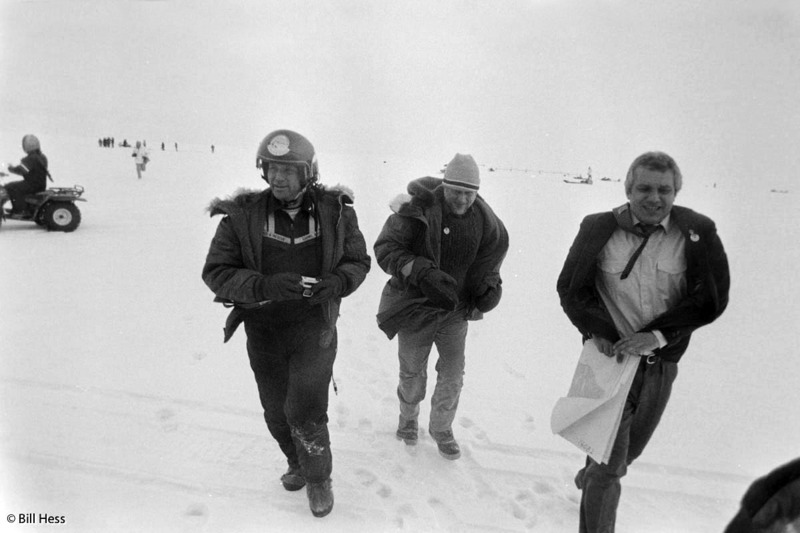
So I scurried over and as I did, I saw Dan, Morris and the Russian man to the right walking in the same general direction. I shot a frame or two and then, when Morris was not looking, hopped into the helicopter and took a seat where I hoped he would not spot me. The Russians boarded. Dan closed the doors. Randy did his pre-ignition check and then, just as he finished, Morris peered at the window and spotted me. A deeply chagrined look swept over his face. Randy started to crank the rotors. Morris shrugged, stepped back, the chopper roared to life. Soon we were airborne, on our way to the Soviet ships.
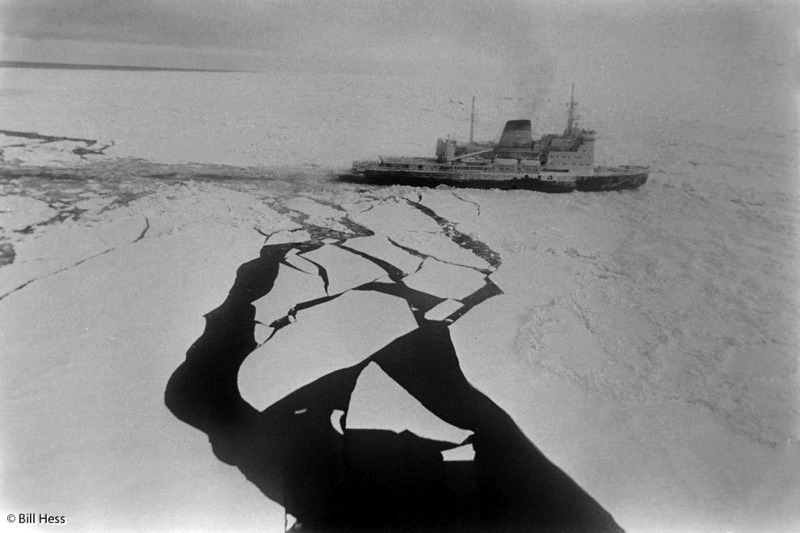
It wasn't long before the ships, the icebreaker Admiral Makarov and the Vladimir Arsenev came into sight. The Arsenev had not been designed as an icebreaker, but a cargo ship, but had been reinforced with ice-breaking capabilities.
"Look at them! Boy! They're really trucking!" I heard Randy's voice through the headset I wore. I was amazed. They were trucking. They were slicing their way through the sea ice at a speed I would not even have imagined.
The Makarov was in the lead...
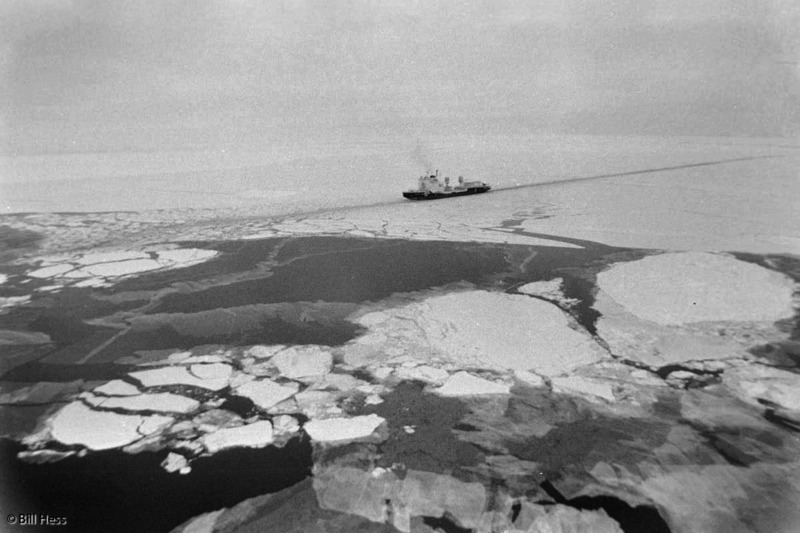
...cutting a channel that the Arseniev followed in.
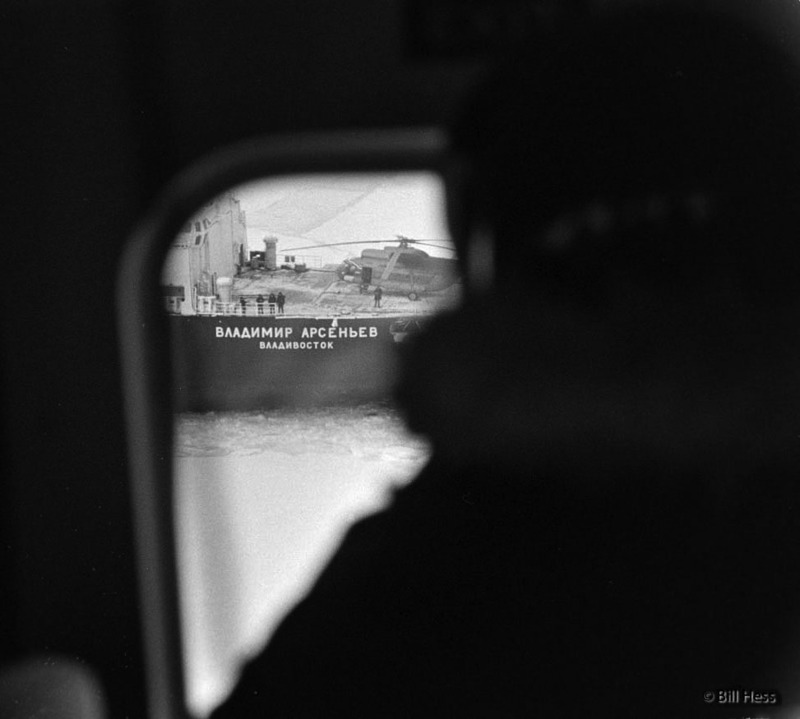
We landed on the Areseniev. As we approached and I saw the deck, the sailors standing on it and the Soviet helicopter on the helipad, I felt hope and excitement - and something just a bit dark and ominous. All my life, I had been taught to fear these guys, the Soviets. Fear them! These Communists who at any moment on any day could fire their atomic armed missiles at us and so set off the catclysm that would be the end of civilization and humanity as we had come to know it; Armageddon.
Captain McClelland was on the Arseniev and we were going to pick him up and take him to the Makarov, but with the helicopter sitting on the heliport, we couldn't land. So we followed along in a holding pattern for a short while. Soon, the helicopter took off. Randy had given the pilot-in-command on this flight to Price Brower, who now had a rapidly moving target to land upon - something he wasn't used to. He made a perfect landing - much to his own pleasure and pride.
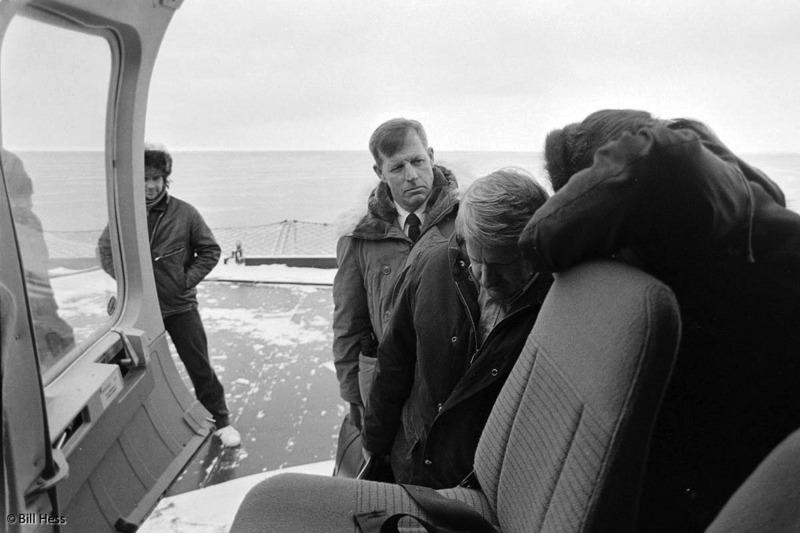
Captain McClelland boarded with a couple of Russians and then we lifted off and headed toward the Makarov. Along the way, we passed over a mother polar bear with two cubs, swimming in a stretch of open water. Yes, I got pictures, but no, I could not locate those pictures to include them here. Someday, I will find them and post them here.
We landed on the Makarov and began to deboard. I spotted the sailor to the left, a classic Russian fur hat upon his head. He had come with a surreptitious mission, which none of us on the helicopter, nor any official or officer onboard, yet knew of.
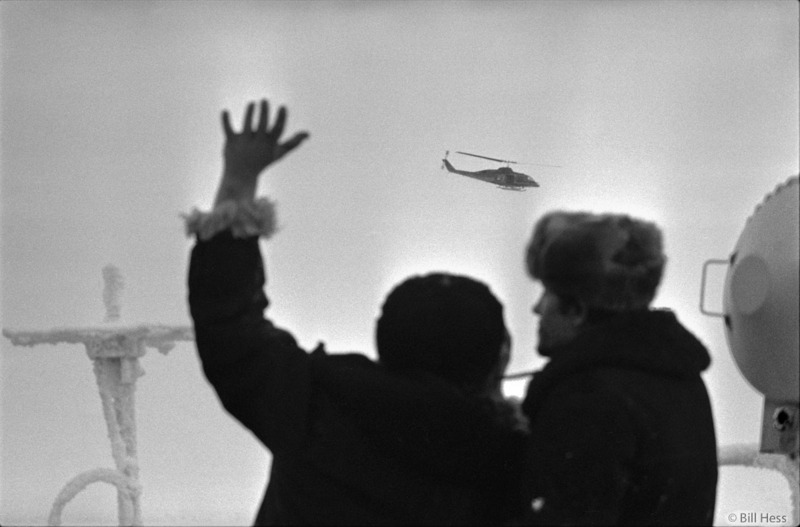
As I was about to follow the captain and the Russians off the helicopter, Randy let me know that he, Price and Dan were about to fly back to Barrow on some kind of mission. I did not want to go back to Barrow until I had spent some time on the icebreaker, but I feared if I got off and started to leave with the group, Captain McClelland, who had witnessed my exchange with Morris and my non-exchange with Rear Admiral Petersen, would take note, point out that I had no authorization to be on the ship and would demand that I return to Barrow.
So I let Captain McClelland walk away, with his back to me. Then I got off. Big Bird lifted off and these Soviet Sailors waved goodbye.
Then it fully dawned on me what I had done. I had deposited myself, alone, on the deck of a Soviet Ship - one that I had no authorization to be on. I scanned the deck of the ship, and studied the huge, sky-scraper like structure that rose above it. It looked awfully damn forebidding - painted white, yet somehow dark, like the Soviet Empire I had been raised to fear. I walked towards it and saw a door, with two sailors standing in front of it.
I walked over. The sailors were very perplexed. They could not understand me and I could not understand them. After gesturing and worried talking among themselves, one gestured to me. I followed him through the door. Inside, the Makarov, built in Finland, was immaculate and clean. My guide started to climb some stairs and I followed. Then we came to a broad, tall-walled hallway with a huge photo mural of pastoral mountain-meadow scene on the wall. We walked down that hall, then entered another door, traversed another flight of stairs and came upon a uniformed man with Asian features. He and I shook hands.
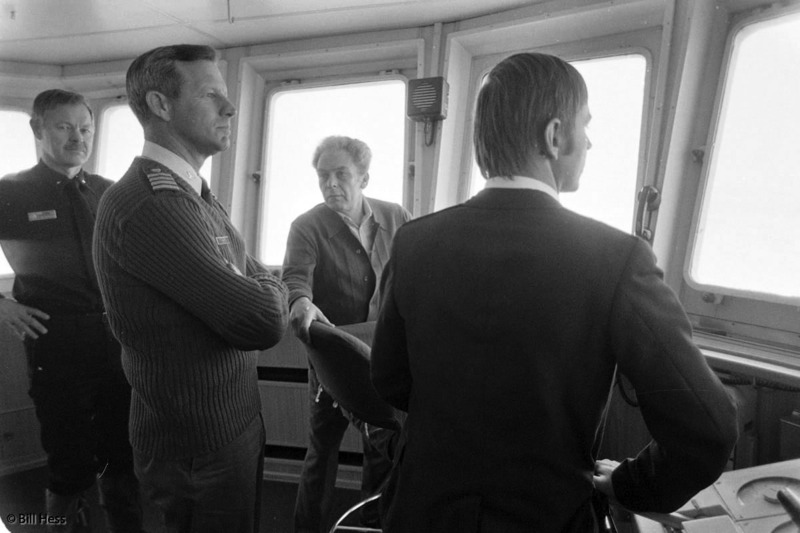
My guide took me up one more flight of stairs, then ushered me through a door into a long room stretching across the width of the ship, fronted by an equally long line of windows looking down upon the bow and the icy sea in front of us.
The first person I spotted was Rear Admiral Peterson, who had been so stone-cold when I first tried to talk him into bringing me along. He stared at me in disbelief. I felt more than a little awkward. Here he was, a Rear Admiral of great power, decked out in fine dress blues. Most of the Soviets I had seen were also sharply dressed.
Here I was, wearing a few layers of well beat, well worn Arctic gear, holes in the outer fabric of my parka, and my insulated pants were frayed, and splotched in the many places where they had been bleached by salt water.
"My mother always told me, `where there's a will, there's a way,'" I greeted him.
He threw back his head, laughed out loud in a way I would not have imagined him capable of from my previous, limited experience. "Welcome aboard!" he said. The interpreter came to see what the levity was all about. She looked at me and then laughed aloud, too.
Captain McClelland was also in the room along with the ships captain and some crew. One sat on an elevated platform with a panel sporting an array of swtiches and levers in front of him. There was no wheel, as such, but he was the steersman. Other instruments in the room sported large computer screens.
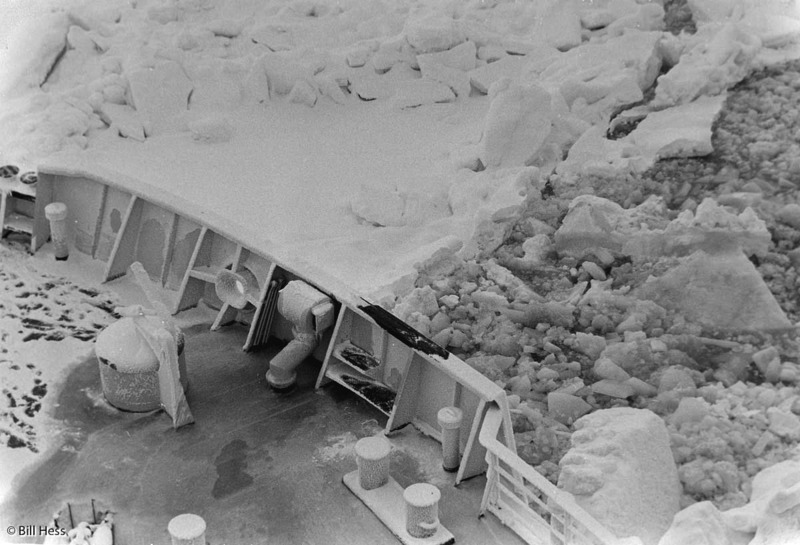
I looked out the window upon an amazing sight. I could see the bow, charging into the ice. The CNN crew stood at the front, camera pointed at breaking ice, but soon turned to walk back to the structure that I was now in. As they did, the cameraman slipped and fell. I shot some pictures, but wondered if I could get on the roof, so I would not have to shoot through the windows.
Once on the roof, I encountered AP's Jack Smith and his reporter. His jaw dropped and angry look came upon his face. He was not happy to see me. He thought he had an exclusive, that he would be the only photographer in the world to cover this critical segment of the rescue. He protested, then realized he could do nothing about it. He then asked me if I would take a picture of him with his camera. I did.
The Makarov had been moving fast, but soon shuddered to a stop. It had encountered a huge pressure ridge. It took a few minutes to back up, then charged forward again. It broke the ridge to rubble and continued through. I went down to the bow, took the place formerly occupied by CNN and shot from there. Sadly, somewhere on that ship, I lost a roll of exposed film. The pictures from the bow must have been on it.
Eventually, as the ice grew heavier and heavier, the Arseniev pulled out from the Makarov's path. Then, working parallel to each other, the two ships began to cut out huge sections of ice. They still had many hours to go before they reached the ridges that blocked the whales.
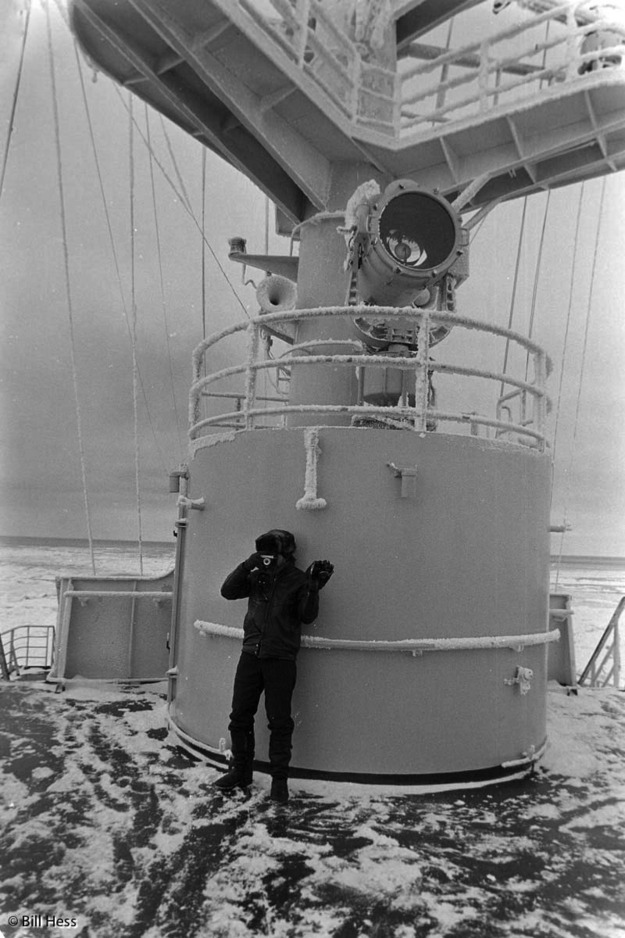
I left my shooting spot on the bow to further explore the deck and soon came upon the fellow who had been standing at the door to the helicopter when we landed. We photographed each other simultaneously, then he gestured to me to come over. He opened a door, and beckoned me to follow. He appeared to be a common seaman. I was a little worried about what might happen if I followed him through the door, but, being there, I had to find out.
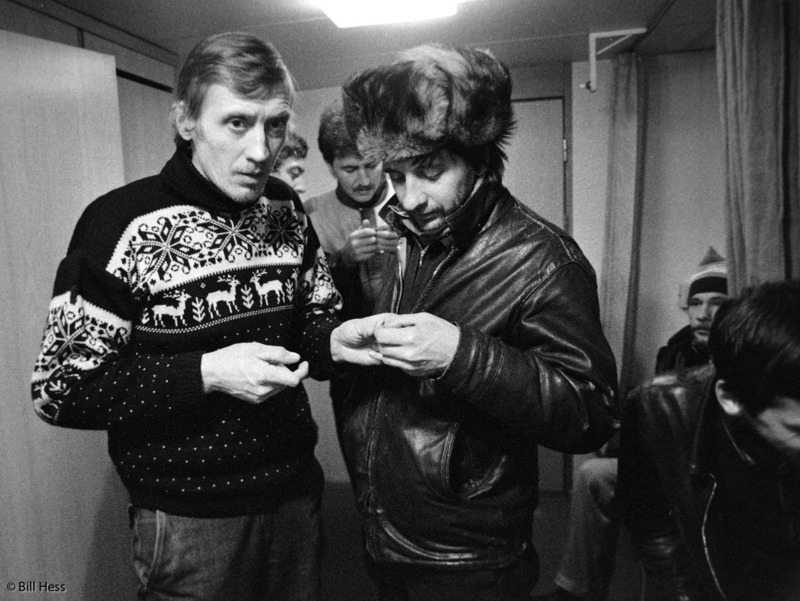
We went down several flights of stairs, into a hallway, past several doors, and then through a door into a bunk room. There was a little table inside with some hard bread on it, and some tiny cans, a large glass bottle, with a couple of chairs off to the side. There were two other men in there, and, much to my surprise, a most attractive young woman with blond hair.
We had been in the room for but a few seconds when several more sailors poured in. I understood then that my escort had gone up top with the sole purpose of fetching an American to present to his immediate shipmates. They motioned for to take my coat off, so I peeled off three layers, and laid them across a bunk. Maybe that's when I lost my roll of exposed film. I placed my camera bag on top of them. I wanted to take pictures, but it felt to me like I should wait a bit, allow them to grow more comfortable with me.
We introduced ourselves. About half of them were named Sasha. The woman was Lora - L-O-R-A, she wrote out the spelling for me. They all called either Moscow or Leningrad as home. All appeared to be in their mid-twenties to late thirties.
None of them spoke English, though one Sasha must have had a course at some point in his life. He knew some words. While I could see no evidence that any of these sailors held any rank over the others, Sasha obviously occupied the alpha role. He also had a special relationship with the woman; whether she was his wife or his girlfriend never became clear to me.
"Coffee?" Sasha asked. A seaman filled the large jar, bigger than a gallon, about three quarters full of water, and then suspended some kind of electronic heating ring into it. The tiny cans each contained about four ounces of coffee syrup, which came out to one serving when poured into a cup, mixed with hot water.
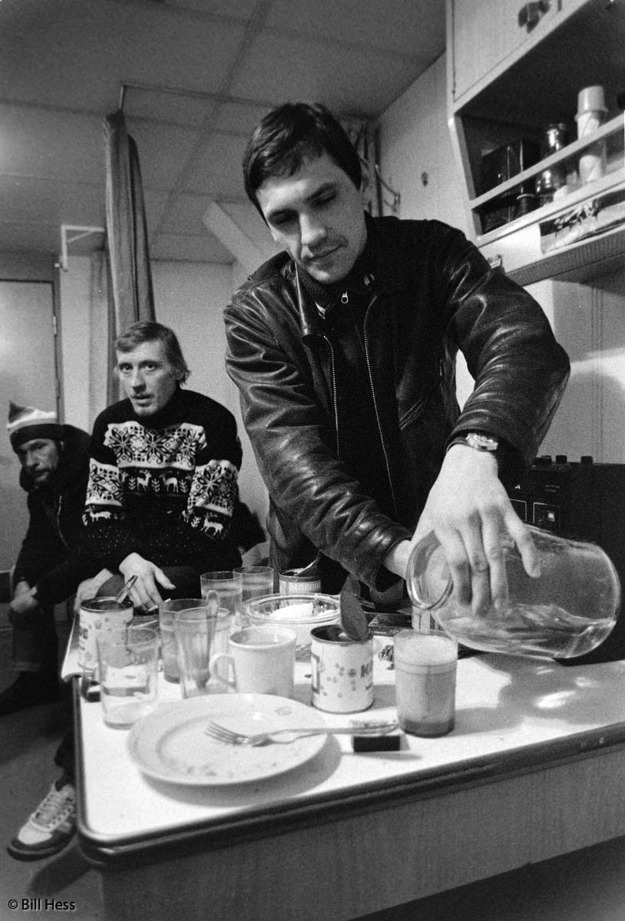
It would take a long, long, time for the water to heat up. In the meantime, we had to figure out how to communicate. My hosts would speak Russian words, accompanied by elaborate hand gestures, deliberate speech, and earnestness. It seemed like they figured that if they spoke slowly and deliberately enough I would understand. I would try the same technique and so we spoke slowly, emphatically and deliberately to each other, understanding nothing.
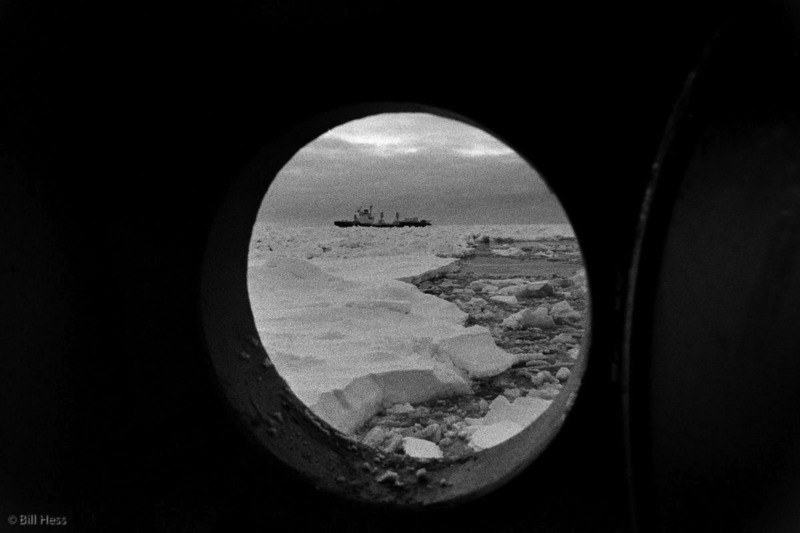
"Bill," the main Sasha would suddenly say, a thoughtful look on his face. He would then launch into some question, which I could not grasp. Finally, he pointed at me, then held his hand, palm down, a short distance above the floor. I realized he had just asked if I had children. Yes, I nodded, then held five fingers up.
"Five?" He responded with his own fingers and a bit of a surprised look on his face. "Five," I nodded.
"Goood," he spoke, then shook his head approvingly. A murmur of approval spread throughout the group, all of whom rocked their heads in slow, definite nods of approval, accompanied by thoughtful looks, their lower lips jutted slightly further out than the upper.
We spoke more gibberish to each other for a minute or so, then the woman whispered something to Sasha. A thoughtful look crossed his face, followed by a nod. He then thrust one finger into the air.
"Present," he said. "Have present." The woman disappeared, but soon returned, hiding something behind her back.
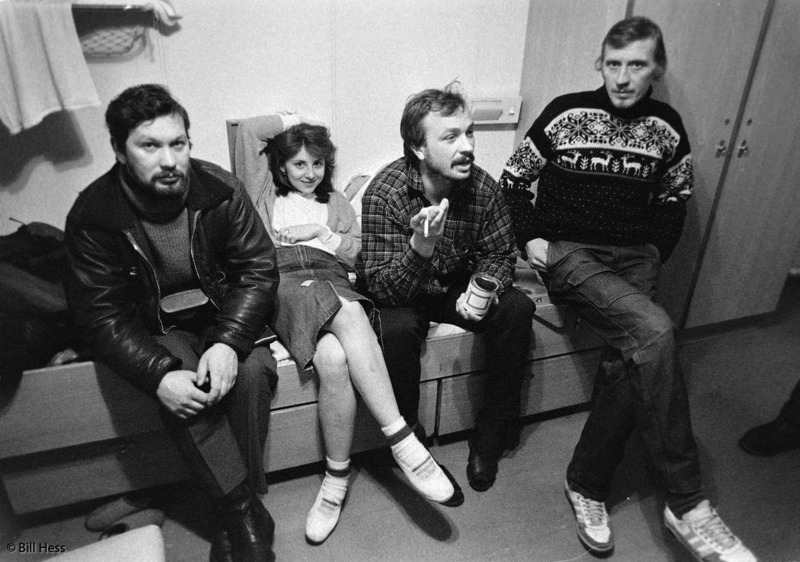
Lora smiled shyly, then handed me a little wooden doll roughly the shape of a bowling pin. A peasant woman and flower decoration had been very nicely painted onto it. It had a seam in the middle, so I opened it up and pulled out a similar doll. Inside it was another, and another, and finally, a very tiny baby-like one. Five in all -one for each of my children.
"Present," another Sasha, said. He handed me a black, leather fur hat. I put it on my head, but it was too small. "Get bigger," he said. He took it back, and came back with another. I placed it on my head, and could detect no difference in size. He looked troubled. His crewmates looked troubled. "Find bigger." Now they all scurried about, until finally the gifter came up with a third hat.
"Bigger," he said, as he motioned for me to try it on. I did. It fit exactlly the same as the first two. He looked at me, very thoughtfully, thrust his lower lip out slightly further than his upper, and nodded a slow, deliberate nod of approval. "Goood."
Everybody nodded approval. "Gooood! Goooood!" I nodded approval. "All right," I said. What could I know give back? I had not even thought such a matter. I had a $50 dollar folding Buck knife in my pocket. No, I couldn't give that. It was a fine knife, of the highest quality. On the Arctic Slope, a good knife is indispensable. I couldn't give up that knife.
But... why not? Fifty bucks? They had already given me something worth more than $50: their goodwill and friendship. I pulled the knife out of my pocket, and opened it up. I could see they were impressed. Sasha picked it up, and took a look at it, while Sasha watched from one corner, and from the other corner, Sasha looked on. This was the original Sasha, the one who sat by the pretty woman.
He nodded very slowly, very approvingly, with a serious, scrutinizing look upon his face. "I take it," he said.
He sat back down by the woman and they consulted among themselves a bit. Then, he pulled a folding knife out of his own pocket. It had about a 3.5 inch blade, along with a saw blade, made out of what, compared to the buck knife, was cheap, soft, steel. The handle appeared to be some type of imitation bone or antler, and had been hand carved. The blade had been honed and rehoned many times and when I tested it later, was quite sharp.
"Good knife," he said. "Saw," he pulled out the little saw, motioning back and forth. "Good."
I took it.
What could I trade next? "Coins," someone said. Of course. I reached into my pocket, and pulled out all the change I had, which included about three quarters, some nickels, a couple of dimes and a few pennies. I held my hand out flat. They all crowded around. Sasha took a quarter, as did Sasha, while Sasha carefully picked up a nickel, looked at it intently, shook his head in approval, and pocketed it.
The non-Sasha's took the rest. In return, everybody handed me coins of different denominations. One gave me a pin, which he managed to let me know symbolized their mission in the Arctic. That reminded me that I had picked up a couple of pins a couple days before at the search and rescue hangar, and had put them in the pocket of my black jacket.
I retreived the jacket, found only one pin, and gave it to him. One fellow looked forlorn, left out. He hadn't done very good on the coin exhange, and had received nothing else. I retreived my new camera case that I had paid to have flown up from Anchorage to replace the one I put into the ocean through the long whale hole. I dug out a roll of T-Max 3200, still in the Kodak box, and handed it to him. He beamed.
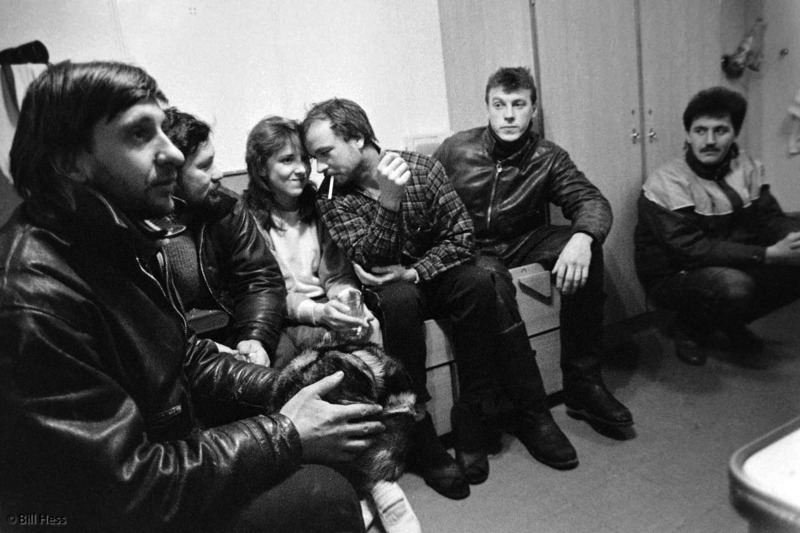
It seemed I was now out of trade goods. I stood there, thinking about it. I still had on my Arctic pants, but they were loose and opened up, exposing my Levi's and belt below. Sasha, the leader, noticed the Levi's and the belt buckle. It was a brass buckle, with a bidarka (kayak-like Unangan boat) on it, a man paddling and the words, "Ounalashka Corporation, Unalaska, Alaska."
It was a gift to me from Vincent Tutiakoff, the president of the Ounalashka Native village corporation. He had presented it to me inside his home in Unalaska. I loved the buckle. It was my favorite of all time - but what the hell. I reached down and started to unsnap it from my belt. "No!" Sasha screamed thrusting his palms out and down in protest. "No!" I kept going. "No! No!" a couple of others joined in the chorus.
The woman looked startled, but curious to see what would happen next. Then I pulled the buckle free from my belt and held it up. A sigh of relief fell over the entire room. Sasha looked the buckle over and fingered it with obvious admiration. He pointed out the Unangan paddler to his mates. "I take it," he said.
Then he disapeared and came back with a belt, with many holes, made to fit many sizes of men, including some very, very big men. He wanted me to have that belt, and he mine. I realized then that the buckle would not attach to any of the Russian belts.
So I took my belt off, gave it to him and I put on the Russian belt.
Sasha then expressed the idea of American bills, but, alas, I had none. They wanted to give me a bottle of vodka for any kind of bill - even a one dollar bill. I didn't have a single bill on me. I regretted it, for I wanted to leave with a bottle of Russian Vodka which, right now, would be sitting unopened on display on one of my office shelves.
Now, I felt comfortable enough to try and take some photos. I got the idea across, and pulled out the old body, with a 24 mm lens. The camera was still too cold. It fogged and frosted right up. I cleaned it off, a few times, but it was hopeless, so I set it aside for a spell.
By then, the water was hot. Was I hungry? Yes. The woman brought me several pieces of fresh and very tasty bread, and a plate, one half covered with rice, the other half with meat cut into chunks and basted in gravy. It was cold, but tasty.
Finally, the fog cleared from my lens. I took a few pictures. The story continues, right up to the point where we were stripping down to go into the sauna as the Big Bird descended onto the Makarov, but I can't let this post go on forever. Probably 75 percent of my readers will take a look at the word length of this post and then click away on to another.
It was growing dark by the time the we landed in Barrow, where we were greeted by a customs agent, flown up for this very purpose. The Soviet ships were considered part of the Soviet Union and so we were treated as though we had visited foreign soil.
All my trade goods got through. I was happy, elated - on a spiritual high, even.
Morris had accompanied us on the return. After we cleared customs and he found a moment to talk to me out of earshot of the others, he let me know that even with the rotors turning, he could have yanked me off the helicopter. He let me know how unhappy he was with me for defying his order to stay on shore. For the remainder of the rescue, he would treat me badly, shun me, literally not speak to me, even when I asked a question. He would ignore, turn his eyes away from me. When the opportunities arose, he would do all he could to hinder my work.
He would almost completely succeed at keeping the North Slope Borough helicopters off-limits to me. I could get around just fine with them, but the aerial shot I had envisioned from the proper angle and height of the whale holes stretching out across miles of ice would never materialize for me.
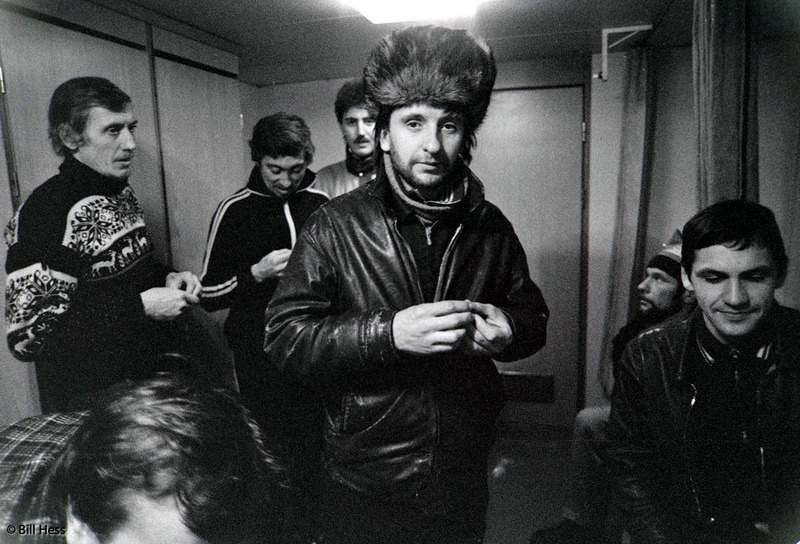
It was okay, though. I had gotten onto the icebreakers. No harm nor hindrance had come of it, but good had. In a tiny way, I had done my part to help melt that ice curtain that had so long stood between two great nations separated by a mere three miles, with the same Native people living on either side. Connections were made between supposed Cold War enemies that would not otherwise have been made. I had a new set of friends in this world - Soviets - not mean, nasty, evil communists, but fellow human beings, just like me. Odds are, we would never again see each other, but we would remember each other throughout all our sentient days.
In my house, there is a pocket knife that I never use; a Russian fur hat that is too small to fit upon my head; a brightly painted wooden doll of a kind that has now become common in Alaska, but was rare then - a doll containing dolls to represent each of my children. Hidden away in a secret place is a stash of Soviet coins. I will never spend them.
p>
Complete series index:
Part 1: Context bowhead hunt
Part 2: Roy finds the whales; Malik
Part 3: Scouting trip
Part 4: NBC on the ice
Part 5: To rescue or euthanize
Part 6: Governor Cowper, ice punch, chainsaw holes
Part 7: Malik provides caribou for dinner
Part 8: CNN learns home is sacred place
Part 9: World's largest jet; Screw Tractor
Part 10: Think like a whale
Part 11: Portrait: Billy Adams and Malik
Part 12: Onboard Soviet icebreakers
Part 13: Malik walks with whales, says goodbye
Part 14: Rescue concludes
Part 15: Epilogue
 Sunday, February 26, 2012 at 8:41AM
Sunday, February 26, 2012 at 8:41AM 